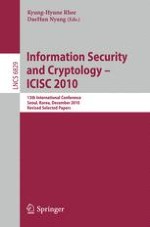This book constitutes the thoroughly refereed post-conference proceedings of the 13th International Conference on Information Security and Cryptology, held in Seoul, Korea, in December 2010. The 28 revised full papers presented were carefully selected from 99 submissions during two rounds of reviewing. The conference provides a forum for the presentation of new results in research, development, and applications in the field of information security and cryptology. The papers are organized in topical sections on cryptanalysis, cryptographic algorithms, implementation, network and mobile security, symmetric key cryptography, cryptographic protocols, and side channel attack.
